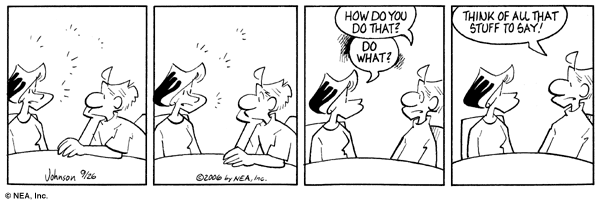Talkative women, taciturn men
Yesterday's Arlo and Janis cartoon is a timely embodiment of the stereotypes that Mark Lieberman's been debunking pseudoscience about (e), over at Language Log lately:

The thing about the pseudoscience in question is, people think it's giving them objective confimation of something they are inclined to believe anyway, but which is mildly un-PC to discuss. This makes it a) very easy to believe and b) both interesting and safe to repeat, since any skeptical or disapproving raised eyebrows can be referred to the supposed(ly) scientific experimental results.
Maybe people experience women as being more talky than men not because they actually are that much more talky (Mark shows that they're not), but rather because people are less patient with women than with men. That is, a speech segment of length X might be perceived as being longer or shorter depending on the sex of the speaker. The idea would be that because women are generally lower-status community members than men, people are less inclined to invest a lot of time in listening to them. (Quiet and respectful attention is something accorded to higher-status people more than to lower-status people, after all.) Consequently, if a lower-status person talks the same amount as a higher-status person does, an interlocutor will perceive that person (negatively) as too talkative, that is, as talking more than their relative status 'should' warrant. If women are, on average, lower-status individuals than men, and if they, on average, talk more or less the same amount as men do, then they'll be perceived as 'talkative'
This would be very easy to test experimentally -- take the same speech segment, say 30 seconds worth; manipulate the pitch to create two copies of the recording identical in all respects except that one sounds like it's spoken by a female and one by a male, and play each to different randomly selected group of subjects. Ask the subjects to estimate the length of the recording (and perhaps for estimates of other factors too: e.g. is the rate of speech above or below average?) Analyze the estimates to discover if subjects tend to estimate that the 'female' speaker talked longer than the 'male' speaker, or vice versa, or neither.
That much would test whether people do in fact perceive women as more talkative than men. Assuming a positive result, the next step would be to test the conjecture that this experiential effect is correlated with social status, perhaps more than with gender. To do this, one would run the same experiment again with just a single recording (either male or female), but giving the subjects one of two short descriptions of the 'speaker' before they listen to it. Half the subjects would hear a description consistent with a high-status individual as the speaker, half would hear a description of a low-status individual. After listening to the stimulus, they'd be asked to estimate the talkiness of the speaker, exactly as in the previous experiment.
Perhaps such work has already been done? Anybody know of any?

3 Comments:
Hi Heidi -- I like your idea. I'm no experimenter, but I think I see some potential design problems.
For the first experiment, modifying the pitch won't be enough to make a natural-sounding male-from-female or female-from-male voice (something I heard Caroline Henton discuss at length once), but maybe there are better audio tweakers out there that will do the trick well enough.
Another thing is the lack of context for the speech segment, which I think might affect people's judgment about it in ways that you're not interested in.
Here's what I'm thinking: what if the speech segment were instead a snippet of a conversation between a man and a woman? It could be engineered so that they technically speak the same amount of time, take turns equally, similar voice affect, etc. Or, the same conversation could be recorded twice, once with the man as "speaker 1" and once with the woman as "speaker 1", with each conversation played to different groups of subjects. (Or both.)
This way you might even be able to get other types of stereotype judgments from the subjects, such as the relative agressiveness/pushiness of each speaker relative to the other.
Dr. Harley!
It's been ages since I visited your blog and was excited by this post for two reasons:
(A) It's about something I think about a lot (people not taking women seriously and/or sterotyping them because they are 2nd class citizens)
(B) The suggested project! Would you mind if I did this or something similar on a small scale for my Speec Tech semester project for Dr. Warner this fall??? Please??? Maybe with a continuum of voices ranging from "very male" to "very female"? I already submitted a project proposal but it's for something boring and Dr. Warner said we can change our project to something cooler if we do so early on.
No, women definetly talk a lot more than men. . . I really don't think it has anything to do with bias. Women are just more communicative. I think.
Post a Comment
<< Home